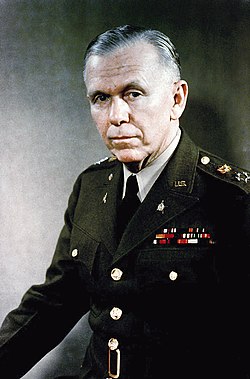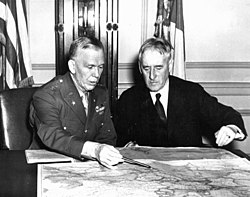George Marshall
George Catlett Marshall (December 31, 1880 – October 16, 1959) was an American military leader. He was Chief of Staff of the U.S. Army during World War II, U.S. Secretary of State (1947-1949), and U.S. Secretary of Defense (1950-1951).
George Catlett Marshall | |
|---|---|
 | |
| 50th United States Secretary of State | |
| In office January 21, 1947 – January 20, 1949 | |
| President | Harry S. Truman |
| Preceded by | James F. Byrnes |
| Succeeded by | Dean Acheson |
| 3rd United States Secretary of Defense | |
| In office September 21, 1950 – September 12, 1951 | |
| President | Harry S. Truman |
| Preceded by | Louis A. Johnson |
| Succeeded by | Robert A. Lovett |
| 15th United States Army Chief of Staff | |
| In office September 1, 1939 – November 18, 1945 | |
| Preceded by | Malin Craig |
| Succeeded by | Dwight D. Eisenhower |
| Personal details | |
| Born | December 31, 1880 Uniontown, Pennsylvania |
| Died | October 16, 1959 (aged 78) Washington, D.C. |
| Political party | Democratic |
| Spouse(s) | Katherine Boyce Tupper Elizabeth Carter Cole |
| Alma mater | Virginia Military Institute |
| Profession | Soldier Statesman |
| Awards | Distinguished Service Medal (2) Silver Star Nobel Peace Prize |
| Signature |  |
| Military service | |
| Allegiance | |
| Branch/service | United States Army |
| Years of service | 1902–1945 also through to 1959 (General of the Army regulations) |
| Rank | |
| Commands | |
| Battles/wars | Philippine–American War World War I World War II |
Marshall joind the U.S. Army in 1902 and served in France during World War I.
As Secretary of State, his name was given to the Marshall Plan. Although the plan was worked out by others in the U.S. State Department, it got him awarded the Nobel Peace Prize in 1953.[1]
George Marshall Media
1900 VMI Keydets football team. Marshall circled
Major General Robert Lee Bullard (center, facing towards his right, photo's left), the newly appointed commander of the 1st Division, and members of his divisional staff at Gondrecourt, France, 17 January 1918. To Bullard's right is Lieutenant Colonel George C. Marshall, the 1st Division's assistant chief of staff for operations.
General of the Armies John J. Pershing and members of his staff standing outside the State, War, and Navy Building in Washington, D.C., 23 September 1919. Pershing is second from left in front row. Marshall is behind Pershing.
Marshall standing behind President Roosevelt and British prime minister Winston Churchill aboard the British battleship HMS Prince of Wales on 10 August 1941
General George C. Marshall with Chief of the Army Air Force General Henry "Hap" Arnold at Villa Urbig on 23 July 1945 during the Potsdam Conference. The two generals return the salute of the Guard of Honor formed by a detachment of Scots Guards of the British Brigade of Guards.
Marshall with Joseph Stalin, Vyacheslav Molotov, and Harry Hopkins at the Tehran Conference in Iran, December 1943
References
- ↑ W. Del Testa, David; Florence Lemoine and John Strickland (2001). Government Leaders, Military Rulers, and Political Activists. pp. 120.









